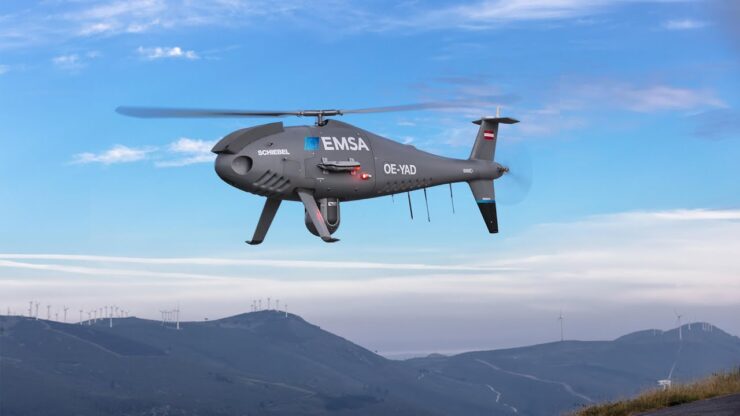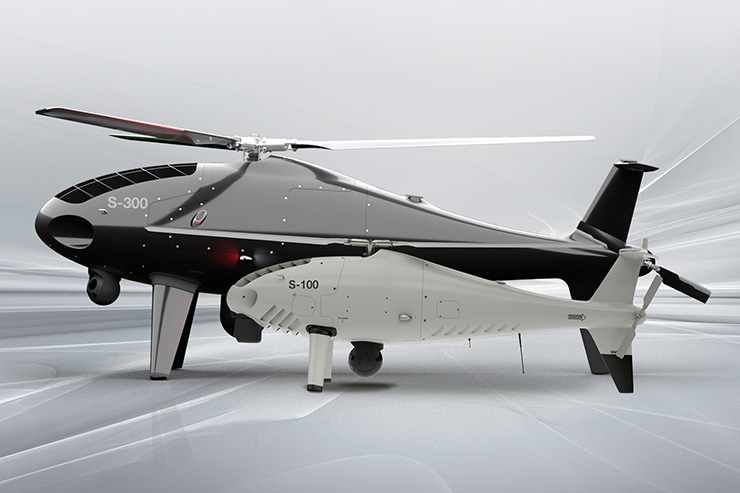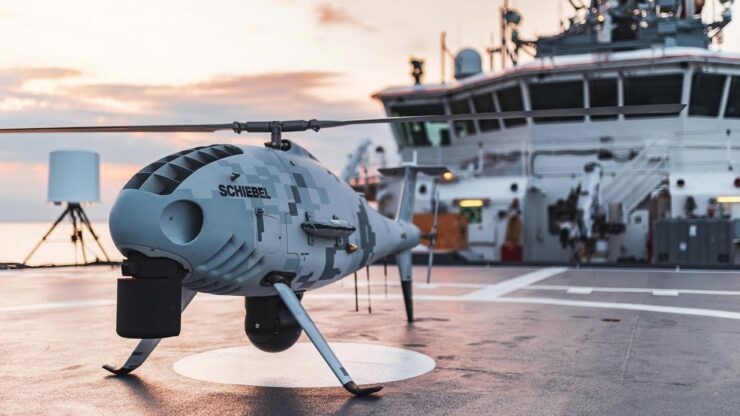
The unmanned drone landscape in India is set to grow sharply in the next decade, so much so that it is poised to become a part of the country’s growth story. In the constantly evolving backdrop of modern warfare, Intelligence, Surveillance and Reconnaissance (ISR) plays a key role and the focus across the world is on Unmanned Air Systems (UAS), with countries vying to outpace each other at a frenetic pace.
The UAS has clearly emerged as a piece of effective equipment to assist the armed forces for ISR and load lifting e.g. in reaching out to soldiers with supplies in time even in the remotest areas.
It’s here that the CAMCOPTER® S-100 is being seen as a mature and proven VTOL (a vertical take-off and landing aircraft is one that can take off and land vertically without relying on a runway) solution for the Indian Armed Forces.
As the only tactical VTOL UAS in its class with more than a decade and a half of extensive operational experience, the CAMCOPTER® S-100 has become a standard workhorse for many satisfied customers in the field of multi-role ISR. The varied requirement for the Indian Armed Forces’ makes the CAMCOPTER® S-100 one of the most suitable and reliable VTOL solutions.
Schiebel’s foray into the Indian market
It was after monitoring the Indian market for several years and witnessing the extensive growth in its UAS requirements – both military and commercial – that Schiebel made its foray into the Indian market in 2020 with a view to tapping a significant share in the billion-dollar opportunities that the Indian market offers.
The Unmanned Air Systems (UAS) have clearly emerged as a piece of effective equipment to assist the armed forces for both long & short range ISR and Operational Logistics e.g. ensuring JIT (Just In Time) supplies /ammunitions to soldiers in remote locations
Schiebel partnered with a well-established manufacturer with its strategy firmly ensconced on meeting the ‘Made in India’ mandate. This partnership venture will manufacture the CAMCOPTER® S-100 along with its payloads under the Buy (India) category with up to 60% indigenisation content.
It will be the endeavour of the partnership to create the necessary skills for the integration and testing in India of the CAMCOPTER® S-100 and to ensure that a robust eco-system is created that can sustain the platform for 15 years and more based on the technology obsolescence.
With the opening of its local office (Schiebel India) and setting up of a production facility with VEM Technologies, Schiebel has ensured that future customer needs in the Indian subcontinent are met effectively and efficiently with a focus on long-term business and steady growth.
Schiebel’s business strategy in India is to support and mature with the Indian industry by creating jobs and developing technology while offering the best Vertical Takeoff and Landing (VTOL) UAS available in the global market. As part of its growth strategy in India, Schiebel has continuously been on the lookout for expanding and strengthening its network.
Schiebel has been exhibiting its product at expos including Aero India 2021, DefExpo 2022 and recently, it showcased the full-scale model of CAMCOPTER® S-100 at the Aero India 2023 expo generating a lot of buzz among potential military customers. Schiebel’s participation in these exhibitions provided it with a holistic picture of the unmanned landscape in India and how it is poised to grow substantially in the Indian market in the next decade.
Currently, Schiebel India is in negotiations with the Indian Navy for its Naval Ship-borne Unmanned Aerial System (NSUAS) Fast Track Program that will deliver a proven tactical maritime Intelligence, Surveillance and Reconnaissance (ISR) capability at sea. It is expected that with the integration of these UAS with the India Navy, a new chapter would herald in tactical exploitation and maritime capability enhancement.
There is also the emerging need for Manned Unmanned Teaming (MUM-T) – combining, for example, the capabilities of the manned ALH, Sea Kings & MH-60Rs with the unmanned S-100. S-100 being the only Rotary UAS at present cleared for LOI-5 where the capability was demonstrated with Airbus manned helicopters, opportunities are galore for its integration with various manned helicopters and being exploited for both ISR and SAR roles. The company is looking to work with the Indian Coastguard for ISR and SAR, and the Indian Army (primarily for Ops Logistics) as well as Indian companies looking to utilise UAS in the oil and gas sector.
There is also the emerging need for Manned Unmanned Teaming (MUM-T) – combining, for example, the capabilities of the manned helicopters like ALH, Sea Kings, MH-60Rs etc. with the unmanned S-100. The company is looking to work with the Indian Coastguard for ISR and SAR (Search & Rescue) roles, and the Indian Army (primarily for operational logistic roles). The civilian sector is not behind and Indian companies are looking to enhance their capability in the UAS sector and hence want to look at options for Rotary VTOL in the oil and gas sector
Operating globally now, Schiebel focuses on the development, design and production of the CAMCOPTER® S-100 Unmanned Air System (UAS). It has cemented its reputation as a reliable producer of high-tech military, commercial and humanitarian products, backed by exceptional after-sales service and support.
Schiebel India CEO Jajati Mohanty says that the unique requirements of the Indian Armed Forces are defined by the types of terrain and the kind of weather that the military has to face on high seas and its borders. The S-100 provides the best option to the Indian Navy, where the weather is unpredictable and an autonomous VTOL UAS is the ideal solution to meet the tactical ISR requirements.
The range and endurance of the CAMCOPTER® S-100 provides a dedicated “eye in the sky” for meeting the needs of the Army, Navy, Air Force and Coast Guard. In addition, the Manned Unmanned-Teaming (MUM-T) opens a plethora of usage options for both the tactical ISR as well as Search and Rescue.
Elaborating further, the CEO indicated that Schiebel operates across the globe and has been active in Asia for a number of years with a strong customer base. “The company has strengthened its focus on the Indian market and with the CAMCOPTER® S-100, a mature and proven Vertical Take-off and Landing (VTOL) solution, we believe we have a very strong offering for the Indian Navy that meets all their requirements,” he says.
The S-100 is a multi-role, multi-domain UAS catering to the specialised needs of navies, armies and air forces alike. The payload-agnostic unmanned aircraft allows customers to add a robust and value-for-money “eye in the sky” to their existing capabilities, allowing for the provision of Intelligence, Surveillance and Intelligence (ISR), search and rescue, environmental protection, vessel detection, cargo delivery and more.
Today as a market leader in rotary UAS, Schiebel has gained extensive experience around the world over the last 20 years and delivered several hundred UAVs to customers globally. Understanding the needs of its customer on a priority basis, Schiebel has been investing 20 per cent of its annual revenue into Research and Development.
The CAMCOPTER® S-100 is continuously being developed using state-of-the-art materials and technology taking into account the customers’ experiences and their feedback.
The CAMCOPTER® S-100 has achieved several hundred thousand flight hours in all climatic conditions and is currently being operated by 14 navies worldwide and used in demanding conditions in more than forty classes of ships, patrol vessels and helicopter carriers.
Having built an international reputation for producing high-tech military, commercial and humanitarian products over the years, the company publicly presented CAMCOPTER® S-300 – a bigger version of the S-100 for the first time at Euronaval in Paris, in October 2022.

An Overview: CAMCOPTER® S-300
- Maximum payload capacity of around 250 kg along with maximum endurance of about 20 hours with a light payload. The CAMCOPTER® S-300 a larger version of the S-100 has given a new twist to the UAV competition in the naval domain and filled a big gap in the heavy-lift-capable unmanned air system (UAS) market.
- CAMCOPTER® S-300 UAS is 4.8 meters long, 1.9 meters high, 0.9 meters wide and can fly at a maximum speed of 120 knots (cruising speed 55 knots). The S-300 is able to carry up to 340 kg (fuel including) and its maximum take-off weight can reach 660 kg.
- The S-300 can also fly up to 24 hours (4 hours with 250 kg) with a 50 kg payload — three times more than what the S-100 can carry. This is essentially what is different between S-300 and S-100.
- A triple-blade folding rotor system allows the storage of S-300 UAV in a standard 20-foot container in the ground control station (GCS).
- In the long run, due to its payload-carrying capacity and endurance, the S-300 is expected to make a big difference as an unmanned asset for high-altitude regions and change the current geopolitical situation.
CAMCOPTER® S-100
- S-100 with several hundred thousand flight hours under its belt is the only established and operationally proven UAV of its class with Anti-Submarine Warfare (ASW), and Intelligence, Surveillance and Reconnaissance (ISR) capabilities.
- S-100 a Vertical Takeoff and Landing (VTOL) is capable of transmitting high-definition payload imagery to the control station in real-time and does not require a prepared area or support equipment for launch and recovery.
- The UAS can operate anytime in day or night, under adverse weather conditions, even beyond the line-of-sight up to 200 km (108 nm) over land and sea. It can carry a 34-kg payload for up to 10 hours using AVGas or JP-5 heavy fuel.
- The S-100 can successfully operate in environments where GPS is not available, with missions planned and controlled using a simple point-and-click user interface. Its carbon fibre and titanium fuselage provide capacity for a wide range of payload/endurance combinations up to a service ceiling of 5,500 m/18,000 ft. The high-tech unmanned helicopter is backed by Schiebel’s excellent customer support and training services.
- S-100 ideally suited to automatically detect and identify even small objects during integrated intelligence, surveillance, reconnaissance (ISR) operations and Search and Rescue (SAR) missions at sea in different weather conditions.
- S -100 200 kg class VTOL UAS is the perfect solution for small ships. The Schiebel VTOL has flown over 100,000 hours and is currently being operated from more than 30 different naval platforms on five continents.

Soon after successfully showcasing the CAMCOPTER® S-100’s impressive capabilities in NATO’s REPMUS (Robotic Experimentation and Prototyping using Maritime Uncrewed Systems) exercise in Portugal sponsored by the Royal UK Navy, Schiebel recently won the UK Ministry of Defence contract “Peregrine” along with Thales. Under the contract, Schiebel will deliver the unrivalled CAMCOPTER® S-100 UAS, fitted with a powerful naval surveillance sensor suite, to provide a comprehensive maritime capability protecting Royal Navy ships on operational tasks. Schiebel and system integrator Thales will provide the operationally proven S-100 with a range of high-precision Intelligence, Surveillance and Reconnaissance (ISR) sensors and systems.
The CAMCOPTER® S-100’s rapid launch ability, superior mission endurance and high-quality sensors combine to find, track and identify targets providing additional protection for the ship and its crew. High-definition imagery and radar data downloaded to the system operator and transmitted in real-time into the ship’s Combat Management System (CMS), provides the crew with invaluable time to prepare and enact operational decisions.

















